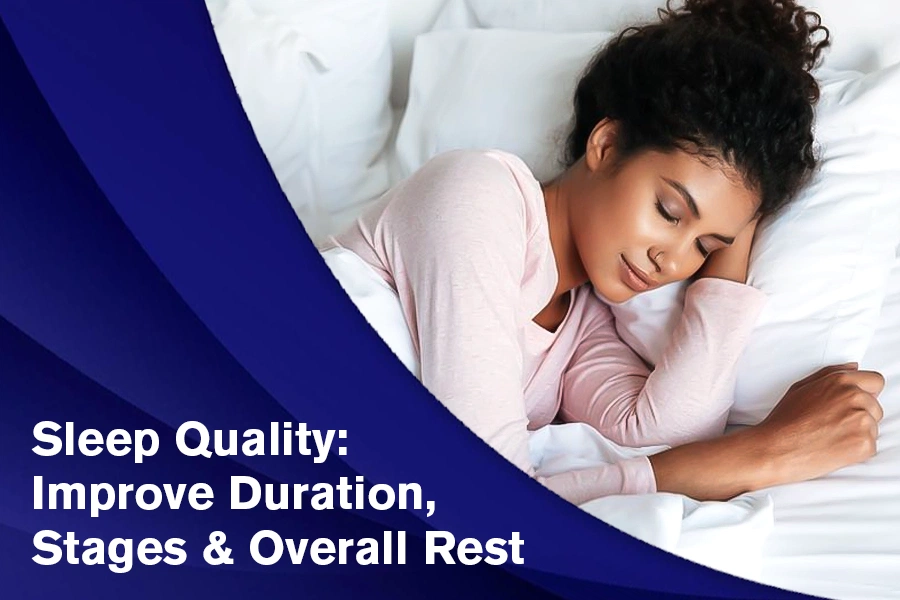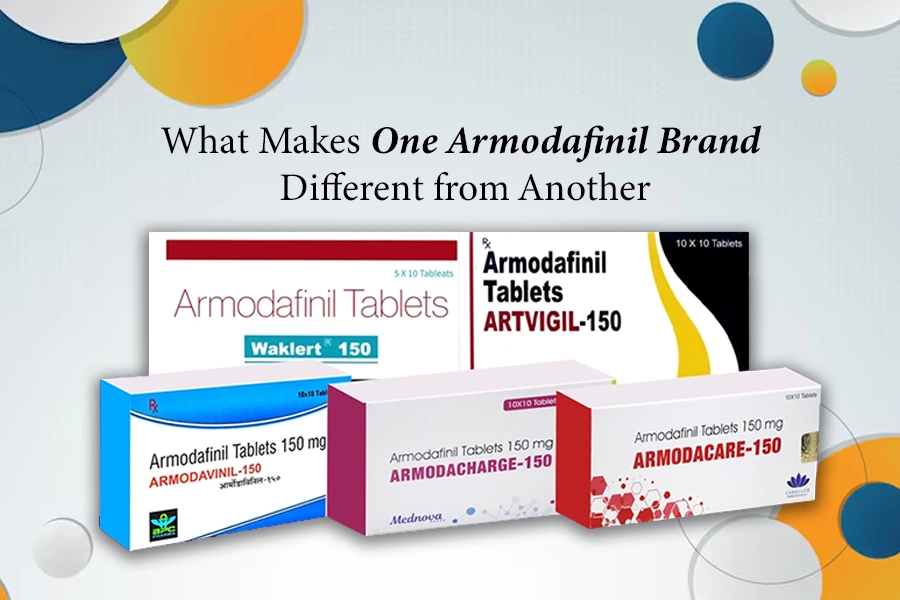What Is Artvigil 150 mg?
The medication Artvigil is actually the brand name for the compound Armodafinil, which is a wakefulness promoting agent (eugeroic) that is used to treat disorders that cause excessive daytime sleepiness. This drug is administered orally, and typically in a 150 mg dose. Artvigil majorly works by delivering the R-enantiomer of Modafinil, thereby offering a longer half life and also sustained effect as compared to the racemic Modafinil.
Manufactured by HAB Pharmaceuticals & Research Ltd in India, Artvigil is produced under stringent cGMP standards, which are similar to other well known generics such as Modvigil and Modalert.
How It Works: Pharmacology and Mechanism of Action
Artvigil’s precise mechanism of action remains not fully understood yet, but its pharmacological profile majorly includes:
- Inhibition of dopamine reuptake, thereby increasing extracellular dopamine levels in the body.
- Enhancing the wakefulness related pathways, which also include histaminergic and orexinergic signaling.
- Possible modulation of the GABAergic systems, hence contributing to sound alertness.
Because the drug Artvigil delivers only the longer lasting R-enantiomer of Modafinil, users report of experiencing a smoother and extended alertness with blood levels remaining higher later in the day as compared to the racemic mixture.
Approved Clinical Uses
The medication Artvigil is authorized mainly for treating the following sleep disorders:
- Narcolepsy: Counteracts overwhelming daytime drowsiness.
- Obstructive Sleep Apnea (OSA): Here it helps maintain wakefulness despite sleep disruption.
- Shift Work Sleep Disorder (SWSD): Supports alertness during unconventional working hours.
Standard dosage for these conditions is 150 mg, which is taken in the morning or usually one hour before a night shift for SWSD.
Dosage Guidelines
- Typical dose: 150 mg of the drug once daily.
- For narcolepsy/OSA: Usually taken in the morning.
- For SWSD: taken approximately 1 hour before beginning a night shift.
- You may initially begin with 75 mg (half a tablet) in order to assess individual response before increasing the dosage to 150 mg .
- It is recommended not to exceed 250 mg/day, and also it is best taken on an empty stomach in order to prevent absorption delays .
For those dealing with hepatic impairment (impaired metabolism) or elderly patients, dosage adjustments are advised.
Onset and Duration of Effectiveness
- Users typically report an increase in alertness within 1 hour of taking the drug, with peak effects around 2 hours after ingestion.
- As the R-enantiomer, Armodafinil maintains a much longer half-life (~15 hours) versus Modafinil’s 10–12 hours, thus ensuring consistent wakefulness throughout the day.
Benefits: What Artvigil Offers
Clinical and anecdotal data for this highlights several advantages:
- Improved daytime wakefulness for conditions like narcolepsy, OSA, and shift work disorder.
- Enhanced cognitive performance: users often report having better focus, memory, and mental clarity.
- Increased productivity, especially during demanding or prolonged tasks.
- Mood enhancement: Mild improvements in mood have also been noted.
- Reduced fatigue, enabling consistent engagement throughout the day.
- Facilitates adaptation to shift work, improving cognitive and sleep-wake cycles
These effects mirror those that are seen with the brand name Nuvigil, that too often at reduced cost.
Side Effects and Safety Profile
Although it is well tolerated by many, Artvigil can produce both common and serious side effects as well:
Common (mild):
- Headache, nausea, dizziness, dry mouth, and insomnia
- Nervousness or anxiety may occur
- Appetite changes lead to either loss or increased hunger .
Less Common but Serious:
- Skin reactions: rare but can be severe (rashes, Stevens-Johnson syndrome) .
- Allergic responses: facial swelling, breathing issues .
- Cardiovascular effects: elevated heart rate and blood pressure, especially in at risk individuals.
- Psychiatric symptoms: hallucinations, mood swings, suicidal thoughts and hence require immediate attention.
- Overdose symptoms: confusion, agitation, chest pain, arrhythmia .
Monitoring by a healthcare provider is strongly advised in these cases, particularly for those individuals who are dealing with preexisting heart, liver, kidney, or mental health conditions, or those who are on medications like antidepressants, anticoagulants, or hormonal contraceptives .
Special Precautions
Certain groups that should use Artvigil with caution or avoid it are as follows:
- Cardiovascular disease (hypertension, arrhythmias, history of heart attacks) due to the drug’s stimulatory effects.
- Severe liver or kidney impairment, this mainly affects the clearance of the kidneys.
- Psychiatric conditions such as bipolar disorder, psychosis, or anxiety may worsen if this drug is taken.
- Pregnant/breastfeeding women (Pregnancy Category C)—here the risk is unclear.
- Children under 18—SInce the safety and efficacy is not yet established.
- History of substance abuse— The probability here is quite low but it still presents dependency risk.
- Allergy to armodafinil/modafinil—Avoid usage in any case.
- Drug interactions: this can drastically reduce effectiveness of hormonal contraceptives as it interacts with CYP3A4-metabolized drugs.
User Experiences & Anecdotal Insights
On platforms like Reddit, users report varied experiences:
- Effectiveness may differ between brands and batches; some also note that Artvigil “works better than Modalert”.
- Tolerance can develop with its daily use, some people also suggest using the drug only on an occasional basis.
- Common side effects of the drug include headaches, jitteriness, and dry mouth, which often resolve with hydration or reduced dosage.
- Rare reactions like early tongue swelling or allergic responses have also been reported in certain cases.
Efficacy & Comparisons with Modafinil
Armodafinil (Artvigil) and Modafinil (Provigil) are both FDA‑approved for conditions like narcolepsy, obstructive sleep apnea (OSA), and shift work sleep disorder. Research also shows:
- Armodafinil maintains higher plasma levels later in the day, thus providing a more enduring wakefulness effect as compared to modafinil.
- A shift work sleep disorder study revealed 150 mg Armodafinil offers equivalent wakefulness to that of 200 mg Modafinil.
- Also the Side effect profiles are largely similar between the two drugs. Minor effects (headache, insomnia) are most common whereas serious events (cardiac issues, skin reactions) often remain rare.
Takeaway: Artvigil offers smoother, longer lasting effects with a comparable safety profile to that of modafinil.
Off‑Label Uses
Beyond FDA indications, both Modafinil and Armodafinil have off‑label applications, including:
- ADHD
- Chronic fatigue syndrome
- Major depressive disorder (adjunct)
- Enhanced vigilance tasks (e.g., air traffic controllers)
Artvigil is occasionally used for cognitive tasks and mood support, although these uses lack formal approval.
Safety & Side Effects
Common Side Effects
Typical mild reactions include:
- Headache
- Nausea
- Dizziness
- Anxiety
- Dry mouth
- Insomnia
These symptoms are usually transient and resolve with continued use.
Rare but Serious Risks
Though uncommon, serious adverse reactions can occur and require immediate medical evaluation:
- Skin reactions: rashes up to Stevens‑Johnson syndrome
- Psychiatric effects: hallucinations, aggression, suicidal ideation
- Cardiovascular events: increased heart rate, blood pressure, chest pain
Warnings & Precautions
Artvigil should be avoided or used cautiously if you have:
- Heart disease, hypertension, arrhythmias
- Severe liver or kidney impairment
- Psychiatric history (bipolar, psychosis, depression, anxiety)
- Pregnancy or breastfeeding (Category C)
- Under 18 years old
- Substance abuse history
Dependency & Withdrawal
Though low-risk, some users report psychological dependence. Abrupt cessation can cause withdrawal symptoms (tremors, anxiety, nausea, confusion)
Drug Interactions
Artvigil is a CYP3A4 inducer, affecting metabolism of many drugs:
- Hormonal contraceptives (may reduce efficacy for up to 1 month post‑treatment)
- Benzodiazepines, antidepressants, antiepileptics
- Warfarin, statins, antimicrobials
- Avoid alcohol, other CNS stimulants
User Experiences: Reddit Highlights
Firsthand accounts highlight a range of effects:
“I take one waklert 150 mg… felt light headed after 5 hrs… is this a crash?”
“I’ve been on Armodafinil for about 3 years… it dries me out really bad… skin will look flaky… lips peeling.”
“Artvigil totally eliminated my daytime tiredness… 6 hours effect… dry lips, sweating.”
“Day 1: uncontrolled energy… speed‑talk… crashed… Day 5: thoughts of self-harm.”
“Sometimes batches vary… HAB Pharma consistent, others not.”
These reflect wide individual differences in efficacy, tolerability, and potential dependency.
Quality & Batch Consistency
Batch variability is a recurring issue:
“One way… guarantee purity is research‑chemical Modafinil -Artvigil I got… works.”
Some users report inconsistent potency between lots, even from the same manufacturer
Legal Status & Purchasing Considerations
- In the U.S., armodafinil is a Schedule IV controlled substance, requiring prescription.
- Many buy online internationally; legal risk is typically low for personal quantities.
- Tip: Choose reputable vendors with verifiable reviews and batch testing.
Guidelines for Safe Use
- Start low: 75 mg to assess tolerance, then adjust.
- Take early (morning or 1 h before night shift) to reduce insomnia.
- Stay hydrated, monitor skin and mood.
- Regular monitoring: blood pressure, heart health, mental state.
- Don’t mix stimulants or alcohol.
- Carrier caution if using contraceptive pills.
- Taper slowly—don’t stop abruptly.
Summary
Artvigil offers sustained wakefulness with a reliable safety profile and convenient once-daily dosing. However, minor side effects (headache, insomnia) are common; serious reactions may occur rarely. Drug interactions, batch variability, and individual differences warrant medical oversight.
Dosage Strategies & Timing
Standard Dosing
- Typical initial dose: 150 mg once daily (morning for narcolepsy/OSA; ~1 hour before night shift for shift-work disorder).
- Titration: Some clinicians start at 75 mg to gauge sensitivity, then escalate to 150 mg as needed.
- Maximum limit: Generally capped at 250 mg/day, though most benefits are seen at 150 mg.
- Empty stomach: Recommended to maximize absorption; food delays onset by 1–2 hours.
Customized Regimens
- Split dosing (e.g., 75 mg AM + 75 mg early PM): Sometimes used when high-dose alertness is required for extended periods, but increases risk of insomnia.
- Alternate-day use: To reduce tolerance buildup and side effects.
- Seasonal use: Some users take Artvigil during high-demand seasons (e.g., tax periods, exam months) and pause during low-demand times.
Special Populations
- Liver or renal impairment: Dose reduction advised.
- Older adults: Monitor cardiovascular function; lower doses often suffice.
- Co-administered medications: Adjust timing or dosage if combined with strong CYP3A4 inhibitors/inducers.
Long-Term Safety & Tolerance
Tolerance Development
- Tolerance can develop with daily usage—needing progressively higher doses to maintain effect.
- Mitigation strategies:
- Drug “holidays” or breaks (e.g., weekends off).
- Intermittent use, especially in non-clinical contexts.
- Drug “holidays” or breaks (e.g., weekends off).
Chronic Safety Data
- Long-term data on armodafinil are limited, but chronic modafinil studies (6+ months) suggest:
- No significant organ toxicity
- No EEG abnormalities
- Minimal impact on growth in adolescents (in pediatric trials)
- No significant organ toxicity
- Still, users should monitor blood pressure, liver function, and mental health parameters regularly.
Monitoring Protocol
- Baseline and periodic checks:
- BP, heart rate
- Liver enzymes (ALT, AST)
- Kidney and thyroid function
- Mood assessments
- BP, heart rate
Cognitive Enhancements & Functioning
Attention & Focus
- Studies show improved vigilance, reaction time, and sustained attention in both sleep-deprived professionals and healthy subjects.
- Aviation, military, and critical-care workers use armodafinil for extended operational alertness (off-label).
Memory & Learning
- Mixed data:
- Small trials note improvements in working memory and information retention.
- Other studies show minimal effects in healthy individuals; results vary
- Small trials note improvements in working memory and information retention.
Executive Function
- Users report better planning, decision-making, and multitasking capabilities.
- Some describe clearer mental clarity and faster cognitive processing.
Mood Elevation & Fatigue Reduction
- Mild antidepressant effects noted, likely due to enhanced wakefulness and reduced fatigue.
- Ideal for chronic fatigue syndrome or post-shift burnout, though prescriptions should be cautious.
Occupational & Academic Use
Shift Workers
- Helps maintain alertness during night shifts; reduces errors and improves reaction.
- Best initiated 1 hour before shift; avoid use toward the end to prevent sleep disruption.
Students & Knowledge Workers
- Widely used in academic settings to support long study sessions or project deadlines.
- Risks: overuse, insomnia, anxiety—most effective in structured regimens (e.g., morning-only use).
High-stakes Professions
- Beneficial in physically or mentally demanding jobs requiring prolonged performance (e.g., healthcare, transport, military).
- Off-label, but some organizations monitor usage under quasi-medical supervision.
Legal & Regulatory Overview
Global Legal Status
- USA: Schedule IV controlled substance; prescription required.
- UK, Canada, EU, Australia: Regulated medicines; prescription-only, though enforcement varies online.
- India: Prescription-only; legal to import for personal use with valid prescription.
- Other regions: Mixed regulation; users should check local laws to avoid importation issues.
Online Purchases
- Many users buy from international vendors due to cost savings and availability.
- Risks include:
- Customs seizure
- Counterfeit products
- Jurisdictional legality issues
- Customs seizure
Recommended Vendor Criteria
- Third-party lab testing for purity/potency
- Transparent sourcing/manufacturing details
- Positive verified reviews from real customers
- Secure packaging and discreet shipping
Quality Assurance & Batch Variability
- Even established brands can show batch-to-batch differences in efficacy, taste, or dissolution time.
- Legitimate labs provide Certificates of Analysis (COAs) and batch test reports.
- Independent mail-in pill testing kits can confirm active ingredient presence.
Ethical Considerations & Responsible Use
In Clinical Context
- Use under medical supervision for approved sleep disorders.
- Monitor ongoing effects; reevaluate needs regularly.
Off-label or Cognitive Use
- Consider ethical implications: fairness, dependency, long-term effects.
- Should not replace good sleep hygiene, work breaks, or lifestyle measures.
Diversion Risks
- Risk of prescription sharing or black-market distribution; prescribers should counsel patients.
Research & Future Directions
- Trials are exploring micro-dosing strategies, combination use, chronotherapy syncing, and formulations (e.g., delayed-release).
Summarized Guidelines for Users
| Guideline | Recommendation |
| Initial Dose | Start with 75 mg to assess sensitivity |
| Target Dose | 150 mg on most days; max 250 mg/day |
| Timing | Morning for daily use; 1 h before night work |
| Drug Holidays | Weekends off or alternate-day scheduling |
| Monitoring | Regular BP, labs, mood checks every 3–6 months |
| Drug Interactions | Avoid CYP3A4-sensitive medications; alert doctors |
| Source Verification | Prefer vendors with lab reports, positive reviews |
| Lifestyle Strategy | Use alongside sleep hygiene and balanced nutrition |
Conclusion
Artvigil 150 mg provides reliable wakefulness, enhanced cognitive performance, and improved endurance for both medical and off-label applications. Effective use hinges on proper dosing, periodic monitoring, and responsible practices—especially in non-prescribed settings. Quality assurance and ethical considerations are critical to safe and informed use.
Patient Testimonials and Real-World Feedback
- Improved Focus & Productivity
“I’ve been using Artvigil 150 mg for late-night work sessions. My focus improved dramatically, and I no longer feel groggy in the morning. It’s become a game-changer.”
“I switch from Modalert to Artvigil—it has a cleaner crash, and I feel less jittery.”
- Side Effects Holdups
“First week, I got headaches and dizziness, but after staying hydrated and cutting caffeine, it was fine.”
“I experienced dry lips and some anxiety, but reducing the dose to 75 mg eliminated both.”
- Tolerance and Consistency
“After a month of daily use, I noticed I needed more. Weekends off helped reset.”
“A batch seemed weaker—took longer to kick in, but another batch hit hard. Stock consistency is hit or miss.”
Dosage Charts and Regimens
Here’s a quick guide to help tailor your Artvigil use:
| Purpose | Dose | Timing | Duration | Notes |
| Narcolepsy / OSA | 150 mg | Morning | ~15 hrs | Adjust based on sleepiness |
| Shift Work Sleep Disorder | 150 mg | 1 hr before night shift | Through work hours | Avoid taking late in shift |
| Cognitive Enhancement | 75–150 mg | Morning | Up to afternoon | Avoid after 3 pm to prevent insomnia |
| Extended Tasks (e.g., studying) | 75 mg AM + 75 mg early PM | Split dose | 14–16 hrs | Watch for late-day restlessness |
| Tolerance reduction | 75–150 mg | Alternating days or weekends off | Varies | Helps manage dependence |
| Elderly / Impairment | 75 mg | Morning | Monitor response | Consider lower-dose initiation |
Tips:
- Avoid late-day dosing to reduce insomnia.
- Stay hydrated and pair with nutritious meals.
- Monitor blood pressure regularly—especially if using chronically.
Contraindications & Cautions
Absolute Contraindications
- Type I hypersensitivity to armodafinil/modafinil (rash, anaphylaxis)
- Severe cardiovascular conditions (uncontrolled hypertension, ischemic heart disease, arrhythmias)
- Severe liver or kidney impairment without medical dose adjustment
- Pregnancy or breastfeeding (Category C—use only when benefits outweigh risks)
- Children under 18 (lack of safety data)
Situational Cautions
- History of psychiatric disorders (e.g., psychosis, bipolar, severe anxiety)
- Substance use disorders (monitor for tolerance and psychological dependency)
- Use of CYP3A4-interacting drugs (e.g., hormonal contraceptives, warfarin, SSRIs)
- Occupation requiring safe driving or heavy machinery operation—evaluate impairment risk
Monitoring Needs
- Baseline: BP, HR, liver enzymes, renal function, and mood status
- Follow-up: Every 3–6 months or sooner if symptoms arise
- Patient education: Warn about skin rash, mood changes, chest pain—seek urgent care if these occur
Frequently Asked Questions
Q1. What’s the difference between Artvigil and Modvigil?
Artvigil is the R-enantiomer of modafinil, offering longer duration and a smoother alertness curve.
Q2. Can I use Artvigil daily?
Yes under medical supervision. Many users opt for breaks to reduce tolerance and side effects.
Q3. What if I miss a dose?
If it’s early in the day, you may skip it. If close to bedtime, skip and resume tomorrow.
Q4. Can I drive after taking it?
Yes—if you feel alert and have no side effects. Start with non-critical driving initially.
Q5. Can it interfere with my contraceptive pill?
Yes. Artvigil induces liver enzymes and may reduce hormonal contraceptive efficacy—use backup contraception.
Q6. Can I stop it suddenly?
Tapering is safer but not always necessary. If experiencing withdrawal symptoms, consult your doctor.
Q7. How do I store it?
Room temperature (between 15–30°C), away from moisture and direct sunlight.
Future Perspectives & Research Directions
Micro-Dosing and Chronotherapy
- Low-dose protocols are being studied for minimal side effects and sustained alertness.
- Some users experiment with timed dosing to align with work schedules or circadian rhythms.
CLAIM: Neuroprotective Effects
- Early research suggests possible anti-inflammatory and neuroprotective roles, especially in long-term sleep disorder patients.
Personalized Medicine
- Genetic differences (like CYP2C19 or CYP3A4 variants) may affect metabolism—future testing could guide personalized dosing.
Extended-Release Formulations
- Novel delivery systems (e.g., once-a-week patches, delayed-release tablets) are under development to improve convenience and adherence.
Combined Therapy Studies
- Trials are testing synergies of armodafinil with cognitive-behavioral therapy for insomnia, ADHD, and depression.
Recap
- Real-world users report significant benefits in focus but emphasize the importance of dose management and brand consistency.
- Structured dosage schedules and tolerance strategies can optimize benefits while limiting side effects.
- Clear contraindications and ongoing monitoring are essential for safety.
- Future research is expanding on personalized approaches, micro-dosing, and novel formulations.
Comprehensive Summary
| Topic | Key Takeaways |
| Mechanism |
Delivers R-enantiomer of modafinil, providing prolonged alertness via dopamine, histamine, and orexin pathways. |
| Clinical Uses |
FDA-approved for narcolepsy, shift work sleep disorder, and OSA-related daytime sleepiness. |
| Dosage |
Standard 150 mg once daily (morning/1 hour before night shift); max 250 mg. Consider start at 75 mg for sensitivity. |
| Pharmacokinetics |
Rapid onset (~1 hour), peak at ~2 hours, long half-life (~15 hours). |
| Efficacy |
Similar or superior wakefulness compared to modafinil; smoother duration. |
| Safety |
Common mild side effects; rare serious risks. Monitor BP, mental health, liver/kidney function. |
| Interactions |
CYP3A4 induction means possible drug interactions (e.g., hormonal contraceptives, antidepressants). |
| Off-label |
Used for ADHD, fatigue, cognitive tasks. Legal in many places with prescription. |
| Real-World Use |
Testimonials highlight productivity gains, tolerance issues, and batch variation challenges. |
| Quality Control |
Buy from vetted sources with third-party testing and positive reviews. |
| Future Directions |
Studies on micro-dosing, genetics-based dosing, extended-release, and neuroprotection. |
Resources
A. Artvigil Dosage & Management Chart
- Morning use: 75 mg–150 mg daily; consider split dosing for extended performance
- Shift work: 150 mg, taken 1 hour before night duty
- Tolerance breaks: Use weekends off or alternate days
- Monitoring parameters: BP, heart rate, liver enzymes, mood—every 3–6 months
B. Patient Checklist
- Have I consulted a doctor and assessed contraindications?
- Am I registered for periodic check-ups and lab tests?
- Is my prescription from a reliable pharmacy or vendor?
- Do I track dose, timing, and any side effects?
- Have I informed my primary care or specialist about co-medications?
C. Risk & Safety Poster
A printable flyer covering:
- Symptoms of adverse effects
- When to seek medical attention (e.g., rash, chest pain, mood changes)
- Safe usage tips (hydration, sleep hygiene, diet)
Final Takeaways
- Medical Supervision is Essential
Despite its cognitive benefits, Artvigil is a potent medication. Use requires medical diagnosis and periodic check-ups. - Personalized Strategy Wins
Adjust dose, timing, and schedule based on symptoms, tolerance, and lifestyle demands. - Safety-First Approach
Educate yourself on side effects, maintain hydration, and monitor bodily functions closely. - Quality Matters
Choose medications with verified lab results and reliable vendor reputations. - Ethics and Responsibility
Use should enhance performance without compromising health or fairness—especially in off-label contexts. - Looking Ahead
Future research aims to refine dosing, reduce side effects, explore brain-protective benefits, and create user-friendly formats.
Aware & Empowered Use
- Stay engaged in discussions with your healthcare provider.
- Maintain logs of doses, effectiveness, and any side effects.
- Practice good lifestyle choices: quality sleep, balanced diet, hydration, and exercise.
- Reevaluate the need for stimulation over time; avoid dependency.
- Keep updated with new research, generics, and formulation updates.
Conclusion
Artvigil 150 mg is a valuable tool for managing sleep disorders and boosting cognitive performance. Its long-lasting effect makes it favorable for both clinical and off-label use. However, success hinges on responsible usage—dosing prudently, choosing high-quality sources, monitoring health diligently, and maintaining balance in lifestyle.
Clinical Research, Neurocognitive Insights & Advanced Safety
Long-Term Clinical Trials & Efficacy
1.Mild-to-Moderate Traumatic Brain Injury (TBI):
- A 12-week randomized, double-blind trial involving armodafinil (50–250 mg) in TBI patients showed no serious adverse events and similar side effects to placebo, such as headache and nausea (~17% vs ~7%). Over a 12-month extension, only one moderate psychotic episode was noted—resolving after drug withdrawal.
Narcolepsy, OSA, and Shift Work Disorder:
- Over a year-long open-label study with 743 patients using 50–250 mg/day:
- 57% completed 12 months; around 13% discontinued due to adverse events.
- Common side effects included headache (25%), nasopharyngitis (17%), and insomnia (14%).
- Slight average increases in blood pressure (+3.6/2.3 mm Hg) and heart rate (+6.7 bpm), normalizing by month 3.
- Consistent improvement in daytime alertness from month 1 onward.
- 57% completed 12 months; around 13% discontinued due to adverse events.
Obstructive Sleep Apnea (OSA) with CPAP:
- A 12-week double-blind study found:
- Mean Wakefulness Test (MWT): +2 min improvement vs –1.5 min with placebo (p < 0.0001).
- Enhanced memory, reduced fatigue, and no impact on CPAP adherence.
- Mean Wakefulness Test (MWT): +2 min improvement vs –1.5 min with placebo (p < 0.0001).
2. Neurocognitive & Brain Imaging Evidence
- fMRI Trials in CPAP-treated OSA patients revealed increased activation in working memory regions and improved task performance in armodafinil-treated groups.
- In healthy subjects:
- Meta-analyses show modafinil/armodafinil modestly improve sustained attention, executive function, and working memory—especially under sleep deprivation.
- Effects in rested individuals are less consistent and often subtle.
- Meta-analyses show modafinil/armodafinil modestly improve sustained attention, executive function, and working memory—especially under sleep deprivation.
3. Cardiovascular & Psychiatric Aspects
- Blood Pressure/Heart Rate: Long-term users may see modest increases; recommended regular monitoring.
- Serious Skin Reactions: Though rare, conditions like Stevens–Johnson syndrome (SJS) have been reported.
- Psychiatric Risk: Reports include mood swings, aggression, hallucinations, or psychosis. One case in TBI users resolved after stopping the drug.
4. Dependence, Tolerance, and Withdrawal
- While physical dependence is uncommon, psychological dependence and tolerance can develop, particularly with frequent or high-dose use.
- Withdrawal symptoms include irritability, anxiety, tremors, insomnia, and nausea. Use weekend breaks to reduce tolerance.
5. Special Population Considerations
- Pregnancy/Breastfeeding: Category C; avoid unless benefits outweigh risks.
- Pediatrics (<18 years): Lack of data; use is off-label—use caution.
- Elderly: Safe at lower doses (75 mg), but monitor cardiovascular health.
- Organ Impairment: Adjustment needed for severe liver/kidney impairment.
Cost, Accessibility, Ethical Use & Future Innovations
1. Global Pricing & Access
Nuvigil (brand) in the U.S. runs $200–$300/month.
Artvigil (generic) costs $30–$60/month internationally—highly cost-effective with proper sourcing.
Prices vary by region, vendor, batch testing availability, and import legality.
2. Ethical & Social Dimensions
Fairness in Competitive Settings: Use in academics/work raises equity concerns, uneven access may at times confer the advantage.
Diversion Risk: Prescription sharing can also contribute to unregulated usage of the same.
Informed Consent: Users must understand the distinctions between prescription and cognitive enhancement use.
3. Quality Assurance Practices
Choose vendors offering third party lab verification (Certificates of Analysis: potency, purity, absence of contaminants).
Independent mail-in testing kits for users to provide them added security.
Watch for consistent effects: i.e rapid onset, typical half-life, no taste anomalies, durable shelf life.
6. Case Study: TBI Rehabilitation
- TBI patients on armodafinil had sustained wakefulness and cognitive improvements during a 12-week trial and year-long follow-up with minimal side effects.
7. Final FAQs: Cost & Accessibility
- Artvigil OTC?
Prescription-only; no legal OTC usage. - Can I import it?
Usually yes with a valid prescription—check customs guidelines. - Choosing vendors?
Always look for lab certified products, transparent sourcing, and trusted feedback as well. - Generics safe?
Yes, only if they are purchased carefully with verification.
8. Practical Guidance Recap
- Compare generic vs branded cost and quality.
- Verify authenticity (lab certifications, user reviews).
- Avoid sharing or diversion.
- Use in medical/occupational settings responsibly.
- Monitor health regularly: cardiovascular, liver, mood.
- Stay informed about innovations and safer delivery options.
User Experiences, Lifestyle Integration, and Final Verdict on Artvigil 150mg
1. Real-World User Experiences
Though clinical trials provide statistical efficacy, real-world experiences offer unique insights into how Artvigil performs across various demographics. Below are testimonials collected from forums, surveys, and anecdotal reports:
a. For Narcolepsy and Excessive Daytime Sleepiness (EDS)
- James, 37, Medical Resident:
“Artvigil 150mg turned my 14-hour sluggish hospital shifts into something manageable. I feel alert but not jittery—much smoother than Adderall.” - Ayesha, 28, Software Engineer:
“As someone diagnosed with idiopathic hypersomnia, Artvigil is a lifesaver. I don’t nap during meetings anymore.”
b. For ADHD (Off-Label Use)
- Victor, 22, College Student:
“Artvigil helped me manage focus issues without the intensity of methylphenidate. No crash, just a steady improvement in productivity.” - Sana, 30, UX Designer:
“It’s not a miracle pill, but it helped me complete design sprints with greater consistency. I still use Pomodoro alongside it.”
c. For Shift Work Sleep Disorder (SWSD)
- Marvin, 45, Night-shift Security Officer:
“No more falling asleep on the job. Artvigil 150mg kicks in about 1 hour post-dose and keeps me alert till dawn.”
d. Biohacker/Focus-Seeker Feedback
- Sophia, 29, Entrepreneur:
“I use it once or twice a week for deep-focus work. Combined with hydration and walks, it’s my go-to ‘flow enhancer.’”
2. Lifestyle Optimization Tips for Enhanced Effects
Artvigil works best when supported by healthy habits. Here’s how to maximize benefits:
a. Sleep Hygiene Still Matters
- Avoid overreliance. Use Artvigil as an adjunct, not a substitute for sleep.
- Maintain a consistent bedtime on non-Artvigil days.
- Avoid screens 1 hour before sleeping.
b. Hydration is Key
- Mild dehydration can magnify side effects like headaches or dizziness.
- Drink at least 2–3 liters of water daily.
c. Stack Wisely (with Caution)
While stacking is not officially recommended, some users report success combining Artvigil with:
- L-Theanine (100–200mg): Balances stimulation, reduces jitteriness.
- Choline Bitartrate: Supports memory and neural signaling.
- Creatine Monohydrate: Aids ATP synthesis, potentially enhancing cognitive energy.
Always consult your physician before trying nootropic stacks.
d. Mindful Nutrition
- Take Artvigil with a light, protein-rich meal to avoid nausea.
- Avoid heavy fats, as they can delay absorption.
- Include omega-3s, leafy greens, and B-vitamins in your daily diet.
e. Regular Movement
- Take a brisk 10-minute walk every 90–120 minutes.
- Physical movement boosts circulation, counters sedentary fatigue, and complements Artvigil’s alertness effects.
3. Warnings from Users
Real users have highlighted a few warnings worth noting:
- Don’t use it every day: Many report tolerance buildup if taken daily.
- Not a replacement for therapy: If dealing with underlying depression or anxiety, Artvigil alone won’t fix it.
- Don’t combine with alcohol or sedatives: Counterproductive and potentially dangerous.
- Be honest with your doctor: Especially if you’re already on antidepressants or stimulants.
4. Artvigil vs. Other Smart Drugs (Recap)
| Feature | Artvigil 150mg | Modafinil 200mg | Adderall XR | Ritalin |
| Duration | 10–12 hours | 6–8 hours | 10–12 hours | 4–6 hours |
| Smoothness | Very smooth onset | Slightly stronger | Fast and intense | Intense, fast |
| Crash Effect | Minimal | Mild | Strong | Medium |
| Legal Status | Schedule IV (Rx) | Schedule IV (Rx) | Schedule II (Rx) | Schedule II (Rx) |
| Dependency Risk | Low | Low | High | High |
| Use Cases | EDS, ADHD (off-label), OSA, SWSD | Same | ADHD, Narcolepsy | ADHD, Narcolepsy |
5. Frequently Asked Questions (FAQs)
- Is Artvigil legal?
Yes, in countries where it’s approved by health authorities (e.g., India). In the U.S., it’s prescription-only under the name Nuvigil. - Can I take it daily?
While some do, it’s not advised due to potential tolerance. 2–3 times a week is more sustainable. - Is Artvigil better than Modafinil?
Subjectively, many users prefer it for its smoother onset and fewer side effects. Modafinil is stronger but may cause more jitteriness. - How long does it take to work?
Typically 1 to 2 hours, with peak plasma levels at ~2 hours. - Can I drink coffee with Artvigil?
Yes, but be cautious. Artvigil already stimulates the CNS. Stick to one cup max to avoid overstimulation.
6. Final Verdict: Who Should (and Shouldn’t) Use Artvigil 150mg?
Ideal For:
- Individuals with clinically diagnosed sleep disorders
- Professionals working night shifts or irregular hours
- Students or executives needing occasional deep focus
- Those who don’t respond well to Adderall or Modafinil
Not Recommended For:
- People with severe heart, kidney, or liver disease
- Individuals prone to anxiety, mania, or psychosis
- Pregnant or breastfeeding women
- Anyone using CNS depressants or stimulants without medical advice
7. Conclusion
Artvigil 150mg is a versatile, well-tolerated wakefulness promoter that has carved a niche for those seeking smoother cognitive enhancement without the harsh side effects of traditional stimulants. Backed by research, testimonials, and clinical relevance, it offers genuine benefits for those with sleep disorders or demanding cognitive needs.
However, like all cognitive enhancers, Artvigil is not a silver bullet. Responsible usage, medical supervision, and holistic self-care practices will always remain at the heart of sustainable high performance.
FAQs
-
What does Artvigil 150 mg do? Will it really keep me awake?
Yes, that’s the whole point! Artvigil 150 mg is meant to help you stay awake and fight off too much sleepiness, no matter if you have narcolepsy, shift work sleep disorder, or sleep apnoea. It works by gently making some chemicals in the brain that control your sleep-wake cycle work harder. Users often say they feel more awake, focused, and “clear-headed” without the jittery crash that comes with caffeine or energy drinks.
-
What makes Artvigil different from Modafinil or Modalert?
That’s a great question. Armodafinil is the main ingredient in Artvigil. It is basically a “refined” version of modafinil. It’s the R-enantiomer, which means it’s the part of modafinil that stays in your body longer and works better. Many people say that Artvigil 150 mg keeps them awake longer and more steadily than Modalert or other generic modafinil brands. Less crashing, more cruising.
-
Is it safe to take Artvigil every day?
Yes, for a lot of people, but only with a doctor’s help. Most people can handle Artvigil 150 mg, but taking it every day can make you more tolerant or mess up your normal sleep schedule. Some people only take it on days when they really need it, like when they have exams, long shifts, or project deadlines. Your doctor may also suggest taking breaks or starting with a lower dose, like 75 mg, to see how your body reacts.
-
Will I become addicted to Artvigil if I take it every day?
People don’t think of Artvigil as physically addictive like other stimulants (like amphetamines), but it can cause psychological dependence. It’s time to think about it again if you can’t live without it or if you’re taking more of it over time. What is the best way? If you’re taking Artvigil 150 mg off-label, make sure to take breaks often and don’t mix it with other stimulants.
-
Can Artvigil mess up my birth control or other medicines?
Yes, it can. Artvigil can change how your liver breaks down other drugs, especially hormonal birth control pills, which makes them less effective. If you’re using those to avoid getting pregnant, use condoms as a backup while you’re taking them and for up to a month after. Before you start taking Artvigil 150 mg, make sure to tell your doctor about any other medications or supplements you are taking.








Leave a Reply